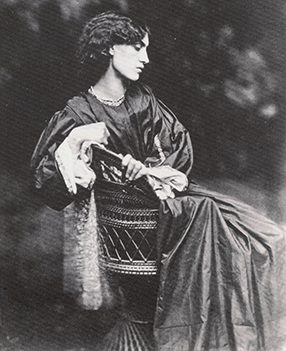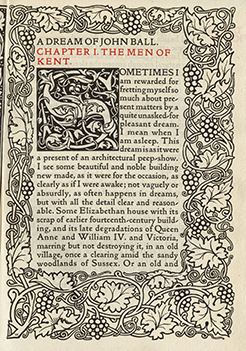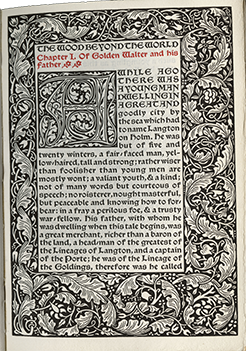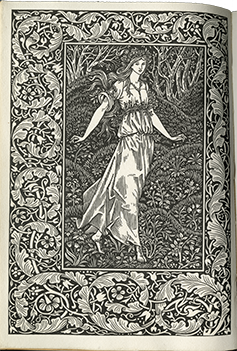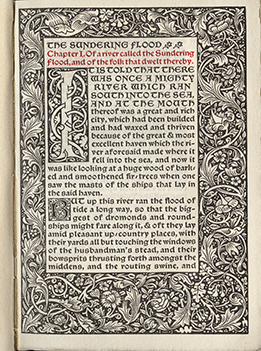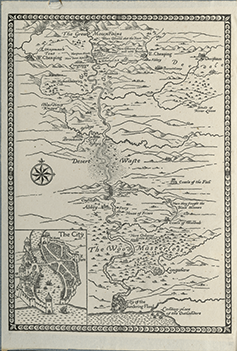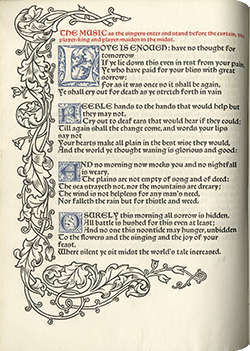A Literary Man: Morris as Author
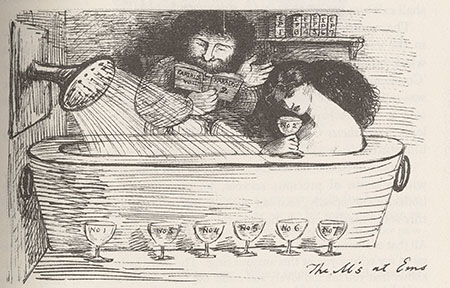
William Morris was famous in his lifetime as a poet and author of literary works. He began writing as a student at Oxford University and published throughout his life. His output encompassed several genres and styles, including narrative poetry, novels, essays, and short stories. When describing himself, Morris would proclaim, "I am a literary man and an artist of a kind. I work both with my head and my hands."
In his literature, Morris incorporated elements of classical poetry and the vernacular romances of the Middle Ages. His poems and novels often contrast the simplicity of life in medieval times with the class barriers that characterized life in the industrialized modern era. Yet, Morris retained a romantic vision of hope in his literary works. His tone of prophetic doom was mitigated by positive themes of love, equality, and the promise of change.
Image: Cartoon of William Morris and Jane Morris titled "The Ms at Ems" by Dante Gabrielle Rossetti, 1869.
"He was in truth a born story-teller - one on whom the spirit of the old bards had descended - and he could not fail to go his destined way."
- May Morris, William Morris: Artist, Writer, Socialist, 1936 -
William Morris, 1856
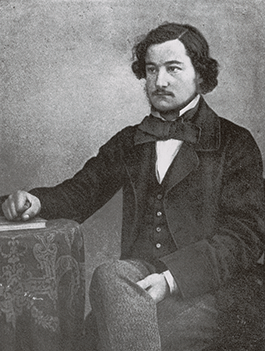
The Hollow Land: and other contributions to the Oxford and Cambridge magazine
by William Morris
London: Longmans, Green, Co., 1903
In 1856, while attending Exeter College in Oxford, Morris edited and financed the Oxford Cambridge Magazine. The publication was created by Morris and a group of like-minded students which included Edward Burne-Jones, Charles Joseph Faulkner, and Cormell Price. The magazine covered a variety of genres, including fiction, architectural criticism, poetry, and social commentary. The Hollow Land and Other Contributions to the Oxford and Cambridge Magazine, is a compilation of Morris's early short stories and poems written for the magazine.
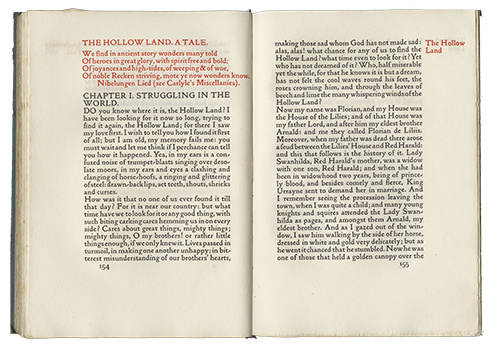
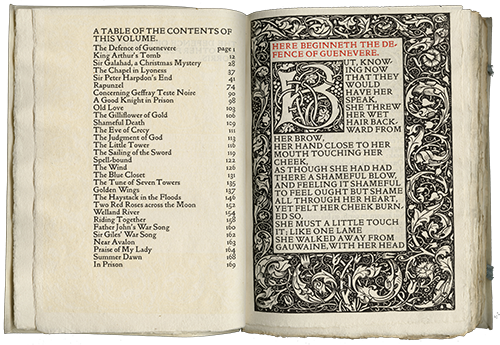
The Defence of Guenevere, and other poems
by William Morris
Hammersmith: Kelmscott Press, 1892
Originally published in 1858, The Defence of Guenevere includes poems written during Morris's days in Oxford, several of which first appeared in the Oxford and Cambridge Magazine. Many of the poems feature tragic themes played out in a medieval setting. The Defence of Guenevere was not well received by critics or the literary public who reacted against its somber mood. The negative response discouraged Morris from publishing poetry for a number of years.
The Life and Death of Jason, a Poem
by William Morris
London: F.S. Ellis, 1869
Morris achieved literary success with the publication of The Life and Death of Jason in 1867. Written at the same time as the Earthly Paradise poems, The Life and Death of Jason was considered too lengthy to be included. It was published as a stand-alone narrative poem chronicling the exploits of the Greek mythological hero.
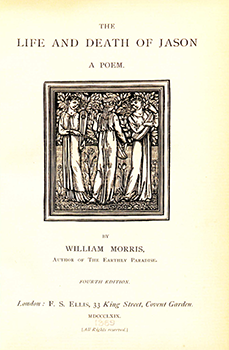

The Earthly Paradise: a poem
by William Morris
London: F.S. Ellis, 1870. 4 Volumes
Earthly Paradise was published in four volumes between 1868 and 1870. The collection of episodic poems loosely follows a group of wanderers traveling the world in search of an elusive land of eternal youth. The text contains many of the hallmarks of Morris's literary style: mythological themes, a melancholy tone and dream-like atmosphere, and most of all the triumph of hope over despair. The publication of Earthly Paradise cemented Morris's fame and popularity as a poet.
A Dream of John Ball and A King's Lesson
by William Morris
Hammersmith: Kelmscott Press, 1892
Many of Morris's later literary works incorporated socialist themes. Originally published in 1888, A Dream of John Ball is a fictional account of the Peasants' Revolt of 1381.
The story is told through the dream of an unnamed narrator. Although the revolt is ultimately a failure, Morris's narrator remains optimistic about the promise of socialist revolution. The persistence of hope is a recurring theme in Morris's literary works.
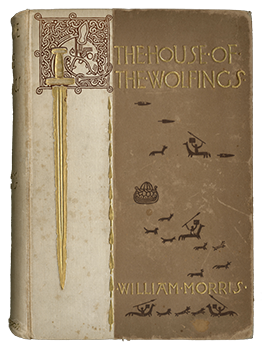
A Tale of the House of the Wolfings and all the Kindreds of the Mark
by William Morris
Boston: Roberts Brothers, 1890
Historical romances comprise the majority of Morris's later writings. These works narrate heroic quests to overcome social injustice. The dense prose and highly imaginative plots of these novels received a mixed reception from readers and critics.
The Wood Beyond the World
by William Morris
Hammersmith: Kelmscott Press, 1894
A Tale of the House of the Wolfings, The Wood Beyond the World, and the other historical romances were written in archaic language evocative of the medieval literature of Geoffrey Chaucer and Sir Thomas Malory. The Internet Archive has a free streaming audio book of The Wood Beyond the World.
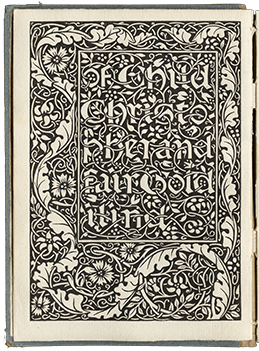
Child Christopher and Goldilind the Fair
by William Morris
Hammersmith: Kelmscott Press, 1895
With their medieval settings and loose connections to medieval folklore, Morris's historical romances set the foundation for the modern fantasy genre. C.S. Lewis and J.R.R. Tolkien cite the later literary works of William Morris as inspiration for their fantasy stories.
The Sundering Flood
by William Morris
Hammersmith: Kelmscott Press, 1897
The Sundering Flood, published posthumously, includes an introductory map illustrating the novel's expansive mythical world - a staple of the modern fantasy novel.
Love is Enough, or, The Freeing of Pharamond: a Morality
by William Morris
Hammersmith: Kelmscott Press, 1897
Originally published in 1873, Love is Enough is dedicated to Morris's wife Jane. In the story, King Pharamond faces the consequences of leaving his kingdom in pursuit of love.
This edition of Love is Enough is one of the few Kelmscott Press volumes printed in 3 colors.
Portrait of Jane Morris
by Dante Gabriel Rossetti, 1865
The melancholy overtones in Love is Enough mark a turning point in Morris's philosophy. The experiences of King Pharamond contrast with those of the hopeful wanderers in Earthly Paradise. Scholars speculate that this shift in Morris's outlook was inspired by the harsh beauty he witnessed during his first trip to Iceland, as well as his wife Jane's long standing emotional affair with pre-Raphaelite artist Dante Gabriel Rossetti.
